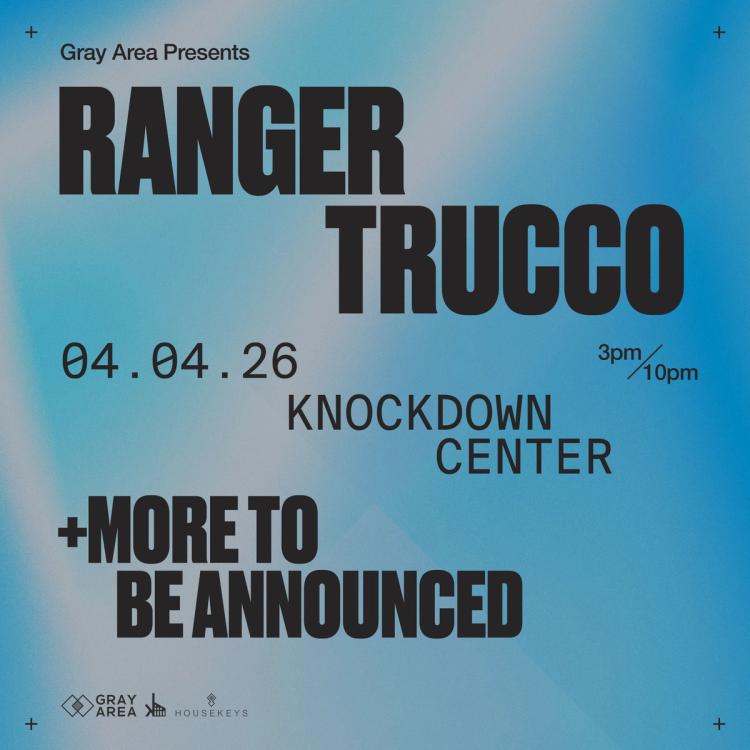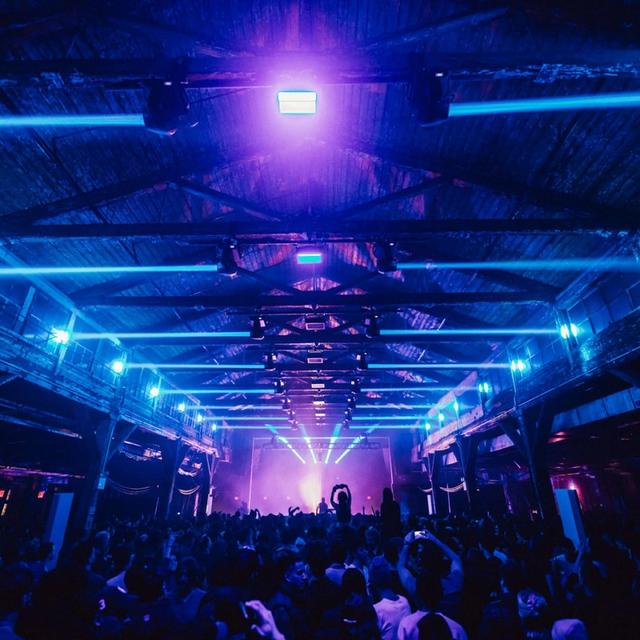
Knockdown Center
Overview
Knockdown Center is committed to offering diverse programming across different formats and media, aiming to foster an interdisciplinary environment. Due to its unique architecture and rich history, the venue gravitates towards projects that showcase a sensitive reactivity to the site and surrounding environment.
The building spans 50,000 square feet and has a storied past, with continuous use for over a century. It started as the Gleason-Tiebout glass factory before becoming the Manhattan Door factory. The building is named after the Knock-Down door frame invented in 1956 by Samuel Sklar, which continues to be an industry standard. This frame could be taken apart—or "knocked down"— and shipped in pieces. The process revolutionized building construction by increasing its speed and efficiency. The Sklar family has retained ownership of the factory, and it continues to be a hub of innovation.
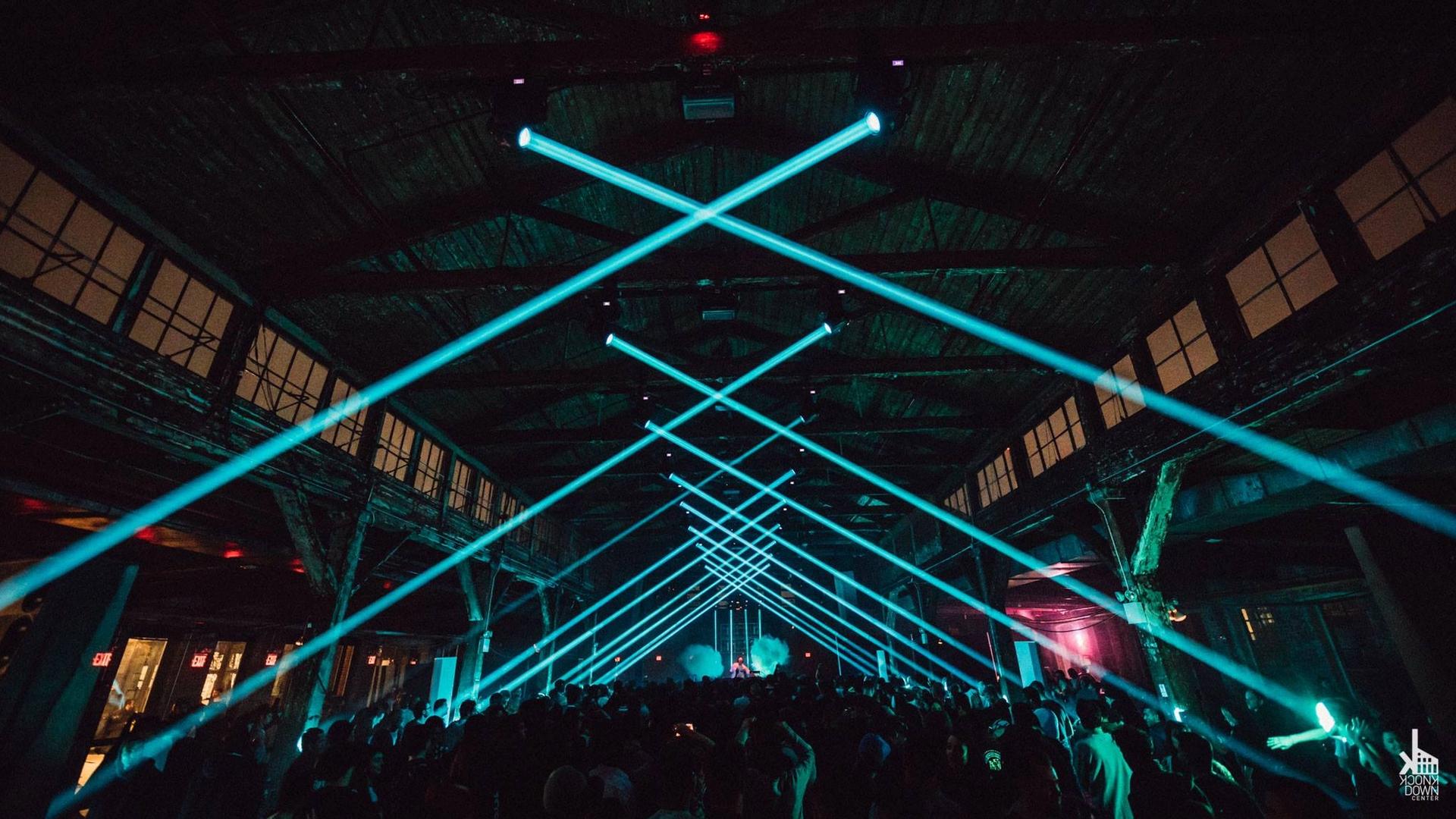
Today, Knockdown Center has undergone a renovation that blends preservationist techniques with state-of-the-art technology. The venue now produces and hosts cultural events and exhibitions that respond to its unique architecture and dimensions. From art exhibitions to musical performances, the space has become a premier destination for creatives of all kinds to showcase their work. Through partnerships with presenters like Gray Area, Knockdown Center has welcomed an impressive roster of artists, including Max Styler, Paco Osuna, Richy Ahmed, DJ Tennis, Patrick Mason, Francis Mercier, Mau P, and many more.
Knockdown Center has nine spaces: Main Space, The Ruins, Gallery, Ready Room, Arizona, Texas, Wood Jamb, Annex, and Basement.
The historic 20,000 square-foot Main Space, which can welcome up to 3,100, was the former site of the door factory. To preserve its unique architecture and heritage, KDC ensured that many of the original features, such as beams and surfaces, were retained during its transformation into a state-of-the-art venue.
The Ruins, which can welcome 1,000–1,500 people, is KDC's backyard. Each summer, it is transformed into a bustling venue that offers a range of exciting activities, including concerts, parties, performances, and community events. The area boasts a spacious 19,000-square-foot poured concrete patio, complemented by a mix of open-air and enclosed structures that were previously used as a boiler room for the factory. As many as 1,550 people can enjoy the warm sun by day and dance the night away under the stars in this outdoor space.
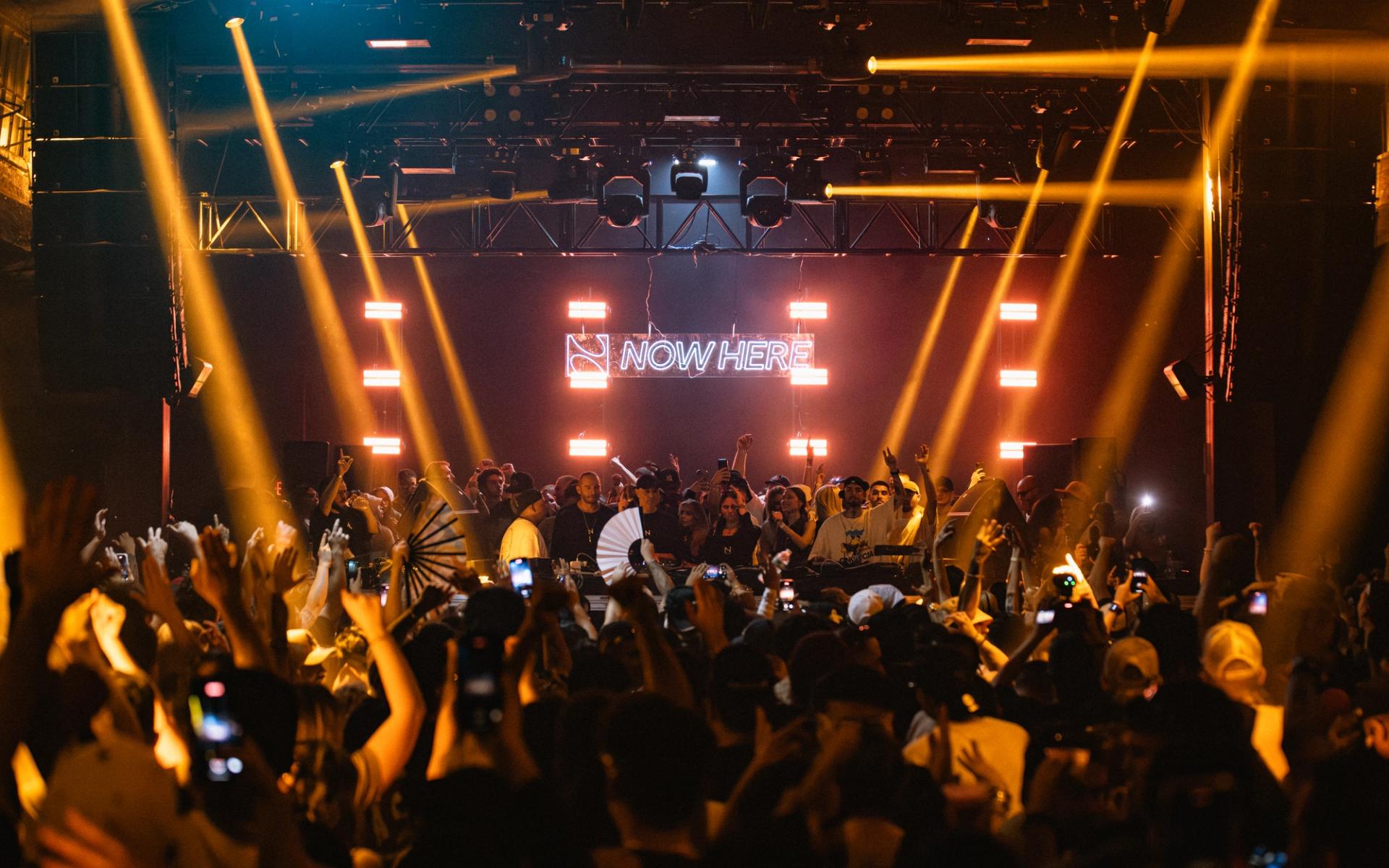
In addition to Main Space and The Ruins, Knockdown Center’s other rooms support a wide spectrum of programming. The Gallery presents large-scale exhibitions, installations, and multidisciplinary projects. Arizona and Texas serve as modular spaces for smaller performances, rehearsals, workshops, or green rooms. The Ready Room and Annex support backstage operations, artist hospitality, and private events. Each space has its own material character, shaped by the building’s industrial past.
At the subterranean level lies BASEMENT, a separately ticketed techno club that opened in 2019. Designed with minimal lighting, a concrete DJ booth, and a custom-tuned Funktion-One sound system, BASEMENT focuses on late-night programming centered around pure techno and house. A strict no-photo policy and curated door entry cultivate a focused listening and dance environment. BASEMENT has become a weekend destination for both international touring acts and local artists. Adjacent to the main room is the Studio, a more intimate setting with a housier sound and windowed chamber feel, which often hosts rising DJs and underground collectives.
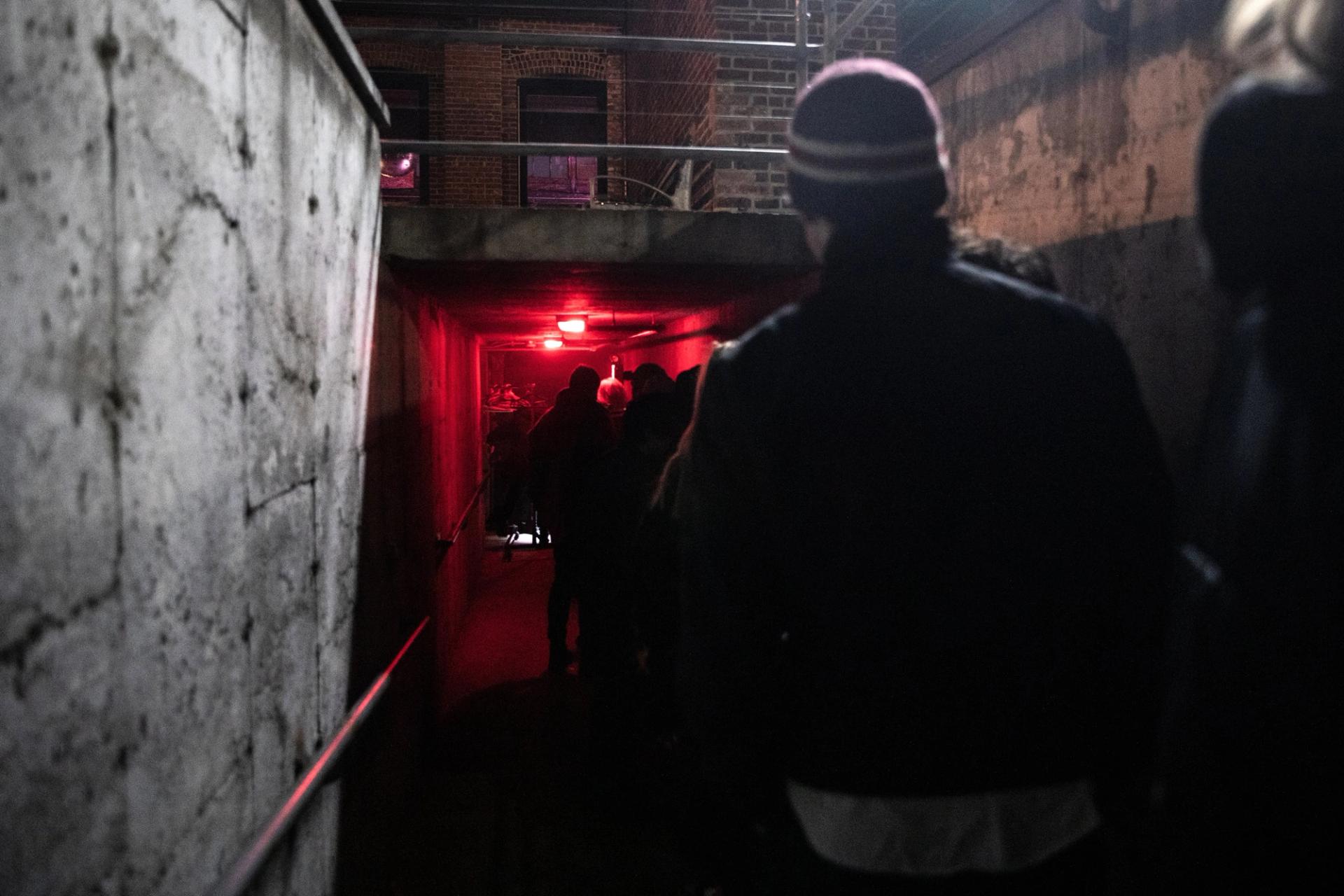
Knockdown Center also organizes and supports a number of annual and recurring events that highlight different communities, genres, and formats. These include Outline Festival, a cross-disciplinary music and performance showcase; WIRE Festival, focused on experimental sound; RUSH, a high-energy club night; and long-running community-driven gatherings like Bushwig, Everyday People, Get Wrecked, 718 Sessions, Horse Meat Disco, and Tiki Disco. The venue also regularly collaborates with presenters and institutions such as Pitchfork, which launched its Pitchfork Presents series here in 2022.
Since 2013, the Center has hosted performances by artists across a wide range of genres and scales—including Wu-Tang Clan, LCD Soundsystem, Arca, Kim Gordon, Turnstile, Frank Ocean, Honey Dijon, Sun O))), James Blake, Fred Again..., CNBLUE, Jeff Mills, Juice WRLD, Kneecap, and Chelsea Manning. Its flexible programming allows it to function as both a large-scale concert hall and a space for more intimate or experimental experiences.

Knockdown Center is located in Maspeth, Queens, just at the edge of Brooklyn, and sits at the intersection of warehouse culture, contemporary art, and NYC nightlife. With roots in manufacturing and a design that values both raw materiality and technical sophistication, the venue continues to serve as a cultural engine for the city and a gathering point for artists and audiences from around the world.
Venue Spotlight
The nightlife migration to New York’s outer boroughs brought with it a renaissance of large-scale clubbing alongside a flourishing underground scene. Nowhere exemplifies this better than Knockdown Center, a behemoth 50,000-square-foot Maspeth, Queens facility that has captured sonic lightning in a bottle. And, better yet, intimacy in a warehouse. The sprawling facility has seen continuous use for 130 years, dating back to its earliest days, first as the Gleason-Tiebout Glass factory and then as the Manhattan Door factory, where the eponymous “Knockdown Doorframe” was produced. For nearly a decade, the multi-purpose art center, a concert venue, and nightlife destination has planted deep roots in the Queens community. With a steady and intentional approach to its programming since 2014, Knockdown Center has cemented its reputation as an avant-garde cultural destination on the leading edge of New York’s house and techno scene. Attracting legendary acts, like Louie Vega, Todd Terry, Honey Dijon, Mr. G, Robert Hood, Fatboy Slim, and recurring favorite Kerri Chandler, Knockdown Center is revitalizing a bygone era of classic club culture for modern times. The now notorious and well-oiled machine — ranked for the second consecutive year in DJ Mag’s Top 100 Clubs — began as a grassroots operation under the direction of executive director and co-founder Tyler Myers. When Myers came to New York, he envisioned a venue that could serve as an eclectic cultural hub for artists from everywhere, of every style. “At Knockdown Center, we aim bring in local and national talent and combine it with an international flair,” says Myers. “We want to show New York City a version of the exciting sonic innovations that are happening in Europe and all around the world.” One of the venue’s first live music events—liquor license still pending—was a 2014 M.I.A. concert presented by Live Nation. After that, the venue continued to engage with the local community and methodically found its footing within the industrial neighborhood on the Brooklyn-Queens border. In 2016, Knockdown Center successfully hosted its first large-scale event: a three-night experimental performance art show called Authority Figure, featuring trailblazing artists SOPHIE, Devonte Hynes (aka Blood Orange), and Caroline Polachek. Today, emerging like a monolith from the concrete of Maspeth, it is one of the most unique venues in this part of the world. A sprawling industrial facility consisting of nine functional rooms that host a variety of musical acts from across the genre spectrum. On the electronic music side, one of the most remarkable features of Knockdown Center is its team’s clear admiration of unadulterated house and techno music. The Atrium, Knockdown Center’s largest and most-programmed room (capacity: 3,100), has recently seen some of the hottest names in dance music — including melodic house mastermind Franky Wah and darling of the tech house scene Cloonee as well as world-class techno acts I Hate Models, PAN-POT and Chris Liebing. This is in addition to the numerous house music mavericks who have graced Knockdown Center’s Atrium: the aforementioned sonic force Honey Dijon, a forefather of deep and classic house Kerri Chandler, the esteemed Body&Soul trio of Danny Krivit, Joe Claussell, and François K, and house music architects Louie Vega, Kenny Dope and Todd Terry. Calling to mind the experience of old-school New York clubbing, the venue eschews the typical staples of modern nightlife. Knockdown Center offers no bottle service or tables, clearing square footage for its sprawling and pulsating dance floor. The Atrium, meanwhile, is outfitted with one of the most impressive lighting systems found throughout the boroughs, with beam lights and strobes running along the length of the cabin-like ceiling and a constant rotation of LED boards, spotlights, hanging lights, and disco balls elevating the experience on any given night. Ray Testa, Head of Operations and a veteran of some of the most esteemed nightlife institutions in New York history (Palladium, Limelight, The Tunnel), plays a crucial role in facilitating Knockdown Center’s communal and inclusive experience. “We cultivate a staff that wants to be here and is emotionally invested in what we do,” says Testa. “We all have the same ideology, with the goal of creating a welcoming guest experience from the minute they walk onto the property. We want people to know: Knockdown is a space where everyone to come as they are, have a good time, know that they’re going to be protected and be with like-minded individuals. And hopefully, even meet people different than themselves and make a connection on the dancefloor.” For its live music programming, Knockdown Center has brought to its stages acclaimed global artists. The venue’s annual cross-genre showcase, Outline Festival, began in 2021. Since, it has welcomed renowned acts, including Grammy-winning Pakistani musician Arooj Aftab and electronic duo Matmos. Other live programming at Knockdown Center has included Venezuelan avant-pop artist Arca and Swedish rapper Yung Lean, among many others. The venue also serves as a hub for a variety of recurring parties: The notorious multi-day drag and music showcase, Bushwig, the illustrious global collective celebrating Black artists and culture, Everyday People, and recently, novelty events like comedian Eric Andre’s raucous 40th birthday party. Moving outdoors, The Ruins at Knockdown Center serve as an oasis in the heat of the New York summer. A stage is inset into the corner of the building, facing a colosseum-like lot of stone and brick to create one of the most innovative and intriguing spaces in all of New York. The past few summer seasons at The Ruins have seen house music stars Hot Since 82, The Blessed Madonna, and Keinemusik, as well as recurring residencies like Eli Escobar’s tropical and tribal Tiki Disco and Danny Krivit’s classic house 718 Sessions. Of course, the story of Knockdown Center’s ascent would be incomplete without a proverbial descent into the BASEMENT. BASEMENT, best described as a Berlinesque club meets labyrinthine Parisian catacombs, is situated directly under the building’s main floor, operating as separately ticketed event space during many weekends. Since opening in 2019—and taking off in 2021—the folklore around BASEMENT has supercharged the space into a premiere underground music destination. “In the most loving way possible, BASEMENT is very dark, and the curatorial vision is very sharp,” says Myers. “There’s not an extensive, but a strong set of house rules for BASEMENT. We sticker phones as people enter and do our best at the door to curate purposeful crowd. We aim to provide a space where people can come dance and be with the music.” BASEMENT’s main room focuses on pure techno, welcoming the likes of Juliana Huxtable, Lydo, and Hiroko Yamamura. It’s outfitted with a Funktion-One sound system and a specially constructed concrete DJ booth with a 32-inch subwoofer directly underneath. Adjacent to BASEMENT’s main room is Studio, a windowed room with dungeon-like passageways which cater to a housier crowd. It’s hosted local and national favorites, including Dee Diggs, DJ Minx, and Michael Magnan. The strict no videos or photos policy keeps the energy concentrated on the dancefloor. The result? Parties that often run until daybreak. Chasing fads is easy. Setting them is difficult. Knockdown Center shows that the ethos of old-school clubbing is alive and well—that the party shouldn’t make the crowd. The crowd should make the party.
Location




